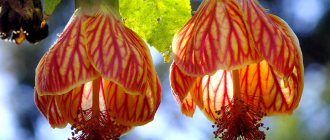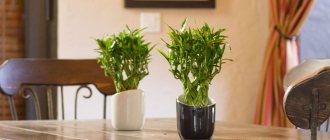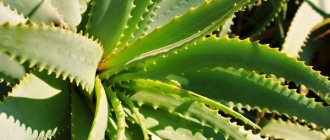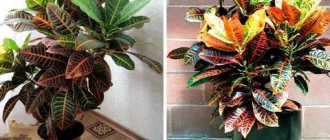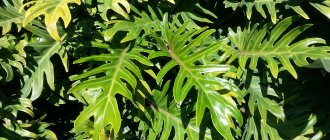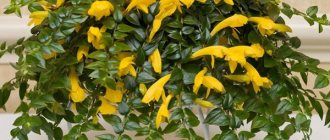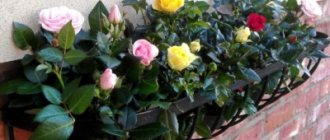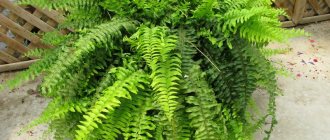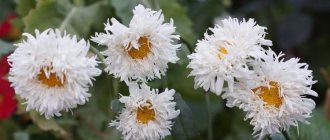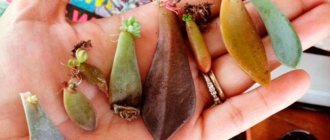Philodendron is an evergreen flowering perennial plant from the Araceae family. Specialists at the Missouri Botanical Garden count approximately 900 species of this plant. All of its representatives have not been fully studied. Philodendrons are common in the tropical zone of America, Australia, and the Pacific Islands. They prefer damp, warm forests, swamps, and river banks.
The name Philodendron is literally translated from Greek as “ I love the tree .” In its natural habitat, this plant cannot grow without the support of its own tree. Several types of philodendrons are grown indoors. Considering the huge size of an adult plant, only owners of large, spacious premises can afford to grow this plant. Philodendron has some similarities with Monstera.
Among philodendrons there are epiphytes, hemiepiphytes and hemiepiphytes. But there are more epiphytes that use aerial roots to attach to a support. If there is no tree next to the plant, it will crawl along the ground behind the shadow of a tree or fence. Philodendron can have both underground and aerial roots. It uses numerous small, hairy aerial roots for support. With thick and long roots it obtains food for itself and absorbs moisture.
The tropical plant has fleshy stems that are woody at the base. The size of the alternate, petiolate leaves in some cases reaches two meters in length. Leaf blades can be oval, pinnately dissected, arrow-shaped. In some cases, the leaves of the same plant may have different sizes and shapes. As a rule, philodendron leaves are colored in different colors, but the upper ones have a darker shade. The inflorescence is a spadix with a waxy two-color blanket that looks like a hood. The fruit is a small berry.
Most plants that belong to the Araceae family are grown in greenhouses and winter gardens. They will decorate large halls and lobbies. For a standard city apartment, the climbing Philodendron is most suitable. This species does not require a large space for normal growth and development. It is grown in a hanging pot or basket like a regular hanging plant. In addition, it is shade-tolerant and unpretentious.
Compact species include Philodendron warty. It has beautiful decorative leaves. But he cannot grow without support. Philodendron Sello is considered no less attractive. Its height reaches 1.5 meters, and it can grow even wider in width, since it has large leaves 80 cm long. The guitar-shaped Philodendron is very beautiful, the leaves of which resemble a famous musical instrument.
Shy but persistent Philodendron blushing vine
Everyone knows that philodendrons are one of the most undemanding indoor plants in terms of lighting. However, among them there are varieties that seem to be specially bred for dark rooms. These include Philodendron blushing - a wonderful, well-developed liana. Even in the northern room she will feel good. Moreover, such lighting will not affect the appearance of the flower in any way - its color will remain just as bright. What else is different about this philodendron and what it loves, let’s find out now.
Diseases, pests and problems in growing
The showy red-purple variety of whole-leaved philodendrons often have problems due to improper care rather than pests or diseases. Both dampness and drought can cause the same reaction - the appearance of spots, blackening of the edges of the leaves. With any hypothermia on the root system, it is practically impossible to avoid rot, as with excessive watering.
The most common pests on blushing philodendrons are spider mites, felt mites, and thrips, which love to spread in extremely dry air. At medium and high humidity levels, they are almost not dangerous for the plant. But scale insects love large leaves and, when infected, the collections spread quite quickly throughout the entire crown.
When purchasing sufficiently mature plants, simpler, smaller leaves may appear during the adaptation period, and this phenomenon is mainly caused by a sharp change in air humidity. If new plants produce “wrong” leaves, it is worth raising the air humidity and gradually changing it, lowering it only when normal growth is restored.
Philodendron blushing - why is it called that?
The vine owes its name to its color. Young leaves, stems and petioles of philodendron first have a beautiful red color. As the foliage develops and matures, it turns green, but the petioles themselves remain red.
This vine is considered to be non-branching. Most often, philodendron grows into one long shoot that bends bizarrely. However, sometimes lateral processes may appear on it.
The leaf plate of the plant is solid, linear in shape. At the petiole itself, the leaf looks like a heart, but then it stretches out, and the tip becomes elongated and pointed. The total length of the sheet is about 20 cm with a width of 15 cm.
Philodendron blushing is a separate type of crop with its own subspecies. The most popular varieties of blushing vine are:
- Burgundy. It grows slowly and needs bright, indirect light.
- Emerald. It has larger leaves up to 25 cm long.
- Jellyfish. The variety is characterized by yellow leaves, while the petioles and stems are red. Grows quickly.
Description of the plant
Philodendron is a tropical flower of the araceae family. This plant exists in the form of a vine, tree, or bush. It first appeared in Indonesia, Australia, Southeast Asia, and Central America.
Of course, the most popular representative of indoor philodendron is the liana. In order for the flower to grow well, it is necessary to tie it to a support. If you don’t do this, the vine will crawl like a lash along the ground behind the shadow of a tree or fence. As for the leaves of the flower, aerial roots form in the axils. They must be tied to a stick holding the vine.
Not all types of such plants are able to coexist in enclosed spaces. Many of them are also found in tropical forests. As for flowering, some vines can reproduce using buds that resemble cobs. Other species of this plant are not capable of this. The philodendron fruit is a small red berry. This plant is considered evergreen and perennial.
This decorative flower has both giant and small sizes. It all depends on the type and place where the plant is grown. In offices and apartments, philodendron grows small. However, if the gardener still wants to purchase a large vine, then she will need a spacious room. The plant injures its feathery leaves when it is in a cramped room. Also, the flower can get frostbite or sunburn if the pot is close to a window or radiator. Such problems arise in summer and winter.
Philodendron has three types of roots: underground, above ground and aerial. Leaf blades are most often found in large sizes. They differ in shape and color. Two types of leaves gradually appear on one shoot: cataphylls and ordinary ones. The stem is mostly soft.
It is worth considering in detail the types of philodendron plants and their detailed descriptions.
Varieties of this plant
There is a huge variety of types of philodendron flower:
- Warty plant. A liana with heart-shaped leaves 15-17 centimeters long and 10 centimeters wide. Also on the leaves, thanks to the light stripes, a pattern is depicted. The petioles are purple in color. Covered with red hairs. The stem itself is soft.
- Philodendron climbing. It grows well in baskets and flowerpots that are hung on the ceiling or wall. The leaves are mostly small in size. They are leathery. They have the shape of a heart. They are 8-15 centimeters in length and 5-10 in width. Basically, this philodendron has dark green small leaves with a velvety surface and a red tint. Over time, the plates become juicy green and shiny. This flower tolerates shade easily.
- Sello tree. Its pinnately incised leaves are shaped like an egg. Their length is 60-80 centimeters or less. The edges of the plates are slightly wavy. The height of the tree is 1.5-1.7 m if it is grown in a house or apartment, but it can grow up to 3 meters in other conditions. The new plant initially has heart- or triangle-shaped leaves, and the color is green or pale green.
- Scale-bearing appearance. This vine has large, feathery leaves. Young plants initially grow three-lobed plates, but adults have five blades. Leaf length: 25-30 centimeters.
- Philodendron bipinnate, notched. The liana has leaf plates, each of which is divided into five lobes. This type of plant in an open space can reach 70 centimeters. But if you grow it at home, it will not grow more than 40 cm. The shape of young leaves is not particularly pronounced, but with age the situation changes.
- Philodendron guitarum. In a closed space, this vine can reach up to 2-2.5 m. The leaf blades have three blades (two lateral lobes are rounded, the central part doubles their length). The stem of the plant needs strong support. The foliage itself has a dark green color with a reflection.
- The stop-shaped flower is a fast-growing species. Its leaves have five to eleven lobes that range from 45 to 70 centimeters in length. The petioles are the same size as the philodendron plates themselves.
- Spear-shaped vine. Its leaves are shaped like an arrow or an elongated heart. Their length is up to 35-40 centimeters. They have a light green color. The liana is capable of growing to the ceiling in a fairly short period of time. She needs support.
- Philodendron blushing. The leaf blades are shaped like an elongated heart. There are red petioles. They reach a length of 40-50 cm. The stem size is small.
What care does the vine need?
The blushing philodendron is a big lover of moisture, as are other types of this vine. It needs to be watered regularly, and the leaves should be periodically sprayed with a spray bottle. You can also wipe them with a damp sponge. The flower loves constancy and will respond to temperature changes by shedding its leaves. The room should be warm; in winter, 12 degrees is enough. But a draft for philodendron is a real killer. Opening windows or the street are not at all intended for vines. It is better to place the flowerpot on a shelf on the wall or place it on an east window.
If you overdo it with watering and spraying, the vine will immediately react to this: drops will appear on the leaves.
To maintain intense color from spring to autumn, the plant must be “fed” with mineral complexes. It is enough to do this twice a month with the same break. In winter, philodendron does not need additional nutrition.
In conclusion, I would like to remind you once again that this rather large vine needs support. Otherwise, the stem will twist itself out in search of something to cling to. Plus, it might break.
Video review of Philodendron blushing
Care errors and their elimination
Common problems when growing philodendron and how to solve them:
Problem
Causes
Solution
Brown spots on leaves
Place the flowerpot where diffused light will fall on it
Drying and curling of leaf tips
Spray the plant regularly and maintain high humidity in the room.
Rotting of stems at the base
Excessive watering, too cold air
Water moderately, do not allow water to stagnate in the pan, keep in a warm room, avoid temperature changes
Falling of lower leaves, stretching of stems
Lack of lighting, too hot air
Place the plant in a well-lit place; if it is not possible to reduce the temperature, spray the leaves more often
Plant characteristics
Philodendron is an ornamental plant that belongs to the Araceae family. In nature, this plant can be found in the tropical rainforests of South or Central America.
Philodendron is a creeping vine whose stems are long, fleshy, and semi-herbaceous.
The plant may have only one short, thick stem. Some Philodendron species have very shortened internodes. These are the so-called rosette plants.
Philodendron's roots are aerial and form from each node. Thanks to these roots, the plant can wrap itself around the tree and climb upward if there is not enough light. When grown indoors, aerial roots should not be removed.
This ornamental plant's leaves can be of different colors, shapes, and sizes. They can be entire or deeply dissected, small, medium or large. The leaves are arranged alternately. The plant can reach up to 2.5 m in length.
The inflorescence has a spadix and a spathe. The plant can produce up to 11 inflorescences.
There are many types and varieties of plants:
Philodendron climbing
It has a twisting stem and abundant aerial roots. It bears matte green leaves, which can reach 14 cm in length. Usually the leaves are heart-shaped, pointed at the end.
Philodendron warty
It is a vine with purple petioles covered with hairs. The leaves are heart-shaped, green-bronze, and can reach 17 cm in length.
Philodendron Climbing (photo)
Philodendron blushing
The leaf blade is elongated, pointed at the end, and can reach a length of 40 cm. The outer side of the leaf is green and glossy, and the inner side has a reddish tint.
Philodendron graceful
Has a thick stem. The leaves are pinnately dissected, oblong or ovate. Their width varies between 30-50 cm, and length - 40-80 cm. This species grows quite slowly; for good development, Philodendron graceful should be placed in a bright room.
Philodendron black and gold
Resembles the climbing Philodendron. The leaves of this species are green with a black tint. At home it can grow to the ceiling.
Types of philodendrons with photos and names
Since there are too many philodendrons both in nature and in culture, we will try to introduce you to the most famous and popular species and forms.
Philodendron golden-black Andre
A highly decorative appearance due to its heterophylly (varieties of leaves): young leaves are small (5-7 cm long) - heart-shaped, copper-red, and adults reach from 40 to 80 cm in length (in nature, of course), more oblong in shape , color – bronze-green with whitish veins and a narrow light border along the edge. At home it is demanding regarding air humidity.
Philodendron brilliant
Small and compact vine. The stems are thin, the leaves are up to 10 cm long and up to 5 cm wide, velvety, young ones are reddish in color, adults are brownish-green. Unpretentious.
Philodendron warty
It is very popular among flower growers because it is incredibly beautiful: heart-shaped velvety leaves 15-20 cm long and 10 cm wide grow on petioles densely dotted with warty bristles. The problem with this species is that it does not tolerate dry air well.
Philodendron guitarum
Also in demand in culture. Its leaves, shaped like a famous musical instrument, reach 40-50 cm in length. The plant is not capricious and has already served as the basis for the breeding of several highly decorative hybrids.
Philodendron bipinnate
Despite the external similarity, which misleads many, these are two different species. They are large vines with a woody, powerful trunk. The bipinnate philodendron is very rare, but the Sello philodendron is widespread in cultivation.
Philodendron blushing
The most famous species among flower growers, which served as the basis for breeders who successfully developed many varieties with its participation. The trunk of the vine is red-green, with age, when it becomes lignified, it turns into gray-golden. The leaf petioles at the base are dark red, the leaves are 25-30 cm long, 15-20 cm wide. The spathe covering the fragrant cob is white - 15 cm long, dark purple. The plant is completely unpretentious and tolerates infrequent watering, poor lighting, and insufficient air humidity.
Philodendron, transplantation and home care
Varieties of Philodendron blushing
Most often, Philodendron blushing is grown indoors. There are several varieties of this plant on sale:
Burgundy variety
Philodendron grows extremely slowly (photo)
It grows slowly. Leaf blades, petioles and shoots are dark red. This variety requires bright and diffused light. Unlike other varieties, Burgundy contains low amounts of chlorophyll. If there is insufficient air humidity, the flower suffers greatly.
Transplanting young and adult plants
Philodendron blushing is transplanted in the following cases:
- with normal development and good growth, the flower is transplanted once every 1-2 years into a pot larger than the previous one in size;
- adult plants should be replanted once every 4 years, but it is recommended to update the top layer of soil frequently;
- when an emergency transplant is required (for illness, etc.).
You should know that in stores such flowers are sold in pots that are completely unsuitable for their further cultivation. Therefore, store-bought philodendron must be immediately planted in a large container with good soil. The pot must be wide and of the required height, and drainage holes must be drilled at the bottom. Before planting, pebbles or expanded clay are placed at the bottom of the container.
If you follow all the rules of maintenance and care, the blushing philodendron can live at home for 20-30 years.
Philodendron propagation methods
When cutting, it is necessary to cut off the upper part of the shoot, on which there are 3 developed leaves. Treat the cut areas with heteroauxin, a special stimulator for root growth. Root the cut shoot in a mixture of peat and sand.
Cover the top with film and place in a room with high humidity at a temperature of 20-22 degrees. You can root not only shoots, but also stem cuttings. They should have a bud and one leaf.
In addition to cuttings, Philodendron can also be propagated by seeds. Pour sterilized soil into a small container and deepen the seeds 5 mm. With this growing method, the temperature should be 25-28 degrees.
The plant reproduces very well by seeds
Cover the top with film or glass to ensure high humidity. The first shoots will appear in 6-7 weeks. After the formation of 2-3 leaves, the seedlings are planted. Very young leaves have a simple shape, and over time they acquire the shape characteristic of Philodendron.
The method of propagation by small fragments of a trunk is carried out as follows: cut pieces of a lignified trunk with one or two nodes. Pour the peat-sand mixture into the container and place the prepared fragments there.
Fold it so that the kidney is on top. Then sprinkle with soil, moisten and cover with plastic wrap. To prevent the cuttings from rotting, the container should be ventilated 2-3 times a week. Once roots appear, they can be planted in pots.
If two Philodendrons bloom at the same time at home, you can cross them.
The soil for plant propagation should consist of peat, bark, coal and sphagnum. All components must be taken in equal quantities. You can add sand, perlite, leaf or grass humus to this mixture.
When pruning the plant, you should use special gloves, as it contains poisonous sap.
Precautions must be taken as the plant sap can cause skin irritation.
Botanical description and photo
Philodendron Scalyum Magic Mask is an exotic plant with large glossy leaves that have deep notches that divide the leaves into two parts. The new leaves that form are the most common, with entire edges. Cutouts appear on them as the plant grows. The flower petioles are long, covered with pink or yellow scales. Over time, the plant develops a strong trunk.
Refers to a collectible type.
Important. The sap of the plant is toxic; use gloves when working. The plant also secretes phytoncides that kill microbes.
When and how to replant Philodendron
Philodendron must be replanted 3-4 years after planting. If the roots of the plant have completely filled the pot, then you can replant it earlier. It is better to transplant in spring or early summer.
The soil should be slightly acidic, loose and nutritious. The pot should be spacious, with a wide base to balance the heavy bush.
Turf soil is often used for replanting.
For replanting, you can use turf soil, coconut substrate, compost, vermiculite as a soil mixture in a ratio of 1:1:1:0.5. In a specialized store you can purchase a ready-made mixture intended for transplanting decorative deciduous plants.
Before transplanting the plant, be sure to lay a drainage layer on the bottom of the pot.
If salt deposits form, a large plant should not be replanted. The top substrate must be removed and the soil replaced.
In some species of Philodendron, after replanting, it is necessary to pinch out elongated branches. This procedure activates the emergence of new shoots.
It should be remembered that the transplanted plant does not need feeding.
Reproduction
In a home or apartment, propagation of reddened philodendron is carried out vegetatively, for which stem or apical cuttings are used. The material is cut in March-April, trying to capture 2-3 internodes. For rooting, it is recommended to use damp moss, into which the cuttings are buried at an angle of 30-45°, covered with polyethylene on top. This will stabilize the high level of humidity; the temperature should be maintained at +25 °C. Rooting usually lasts 7-30 days.
Another method involves rooting the cuttings in a greenhouse, and then transplanting them into small pots when they grow steadily.
Another method of obtaining a new plant is to use a piece of stem with aerial roots, where it needs to be wrapped in film, in which damp moss is placed. The moss must be moistened periodically until a good root system is formed.
After the roots have formed, the stem is cut off at the bottom, and the plant is transplanted into a pot with prepared soil mixture along with moss.
Plant care
The plant is unpretentious in care, but at the same time it requires compliance with certain rules.
Philodendron tolerates low temperatures very poorly. Temperature changes will lead to the death of the plant. For good growth in the room where the Philodendron is located, the temperature should be 16-25 degrees. In winter, the temperature should not fall below 12 degrees. Philodendron does not like drafts.
It is important to ensure that direct sunlight does not fall on the leaves. The light should be bright and diffused. Therefore, it is better to place an ornamental plant on eastern or western windows.
The plant should be watered with settled water at room temperature. In summer, watering should be plentiful.
Between waterings, you must ensure that the soil dries out, otherwise the plant may die. With the onset of autumn, watering should be reduced. In winter, watering should be done even less often. In summer, it is advisable to spray the leaves of the plant.
For good growth and development of the plant, high humidity is required. To ensure high humidity, the pot with Philodendron must be placed in a tray, first filled with wet expanded clay or pebbles.
It is advisable to fill the bottom with pebbles
It is recommended to wipe the plant leaves once a week with a damp sponge.
The ornamental plant is rarely exposed to diseases. They occur when care rules are not followed. Sun rays can cause leaf burn. As a result, the leaves will begin to turn yellow and fall off. This is also observed in dry indoor air.
As a fertilizer for Philodendron, you can use a mixture consisting of nitrogen, potassium and phosphorus in equal proportions. It is advisable to feed every 2 weeks. You can buy fertilizer for Philodendron at a flower shop. In winter, there is no need to fertilize the plant.
If Philodendron is located in a warm room, then fertilize it with a small amount of mineral mixture once a month. It is important not to overfeed the Philodendron. This may primarily affect the leaves.
Lack of nutrients due to infrequent feeding will affect plant growth and stem thickness.
I have a large garden and vegetable garden, several greenhouses. I love modern methods of cultivating plants and mulching the soil, and I share my experience.
Regarding lighting, it is worth considering that species with variegated foliage need more light than those with a single color. If you want to grow this flower, but the windows are not lit enough, give preference to the climbing Philodendron and the blushing Philodendron. They tolerate partial shade normally, and in appearance they are not inferior to other forms.
Although this flower loves to be watered, there should be no moisture left in the tray. If the leaves turn yellow, this means that there is too much moisture and it is worth changing the watering regime. If the foliage begins to fall off, this indicates that the soil in the pot is drying out, which also should not be allowed. It is important that the water for irrigation does not contain lime, otherwise stains will begin to appear on the leaves.
If the leaves become smaller, it means the air is too dry for the flower. You should especially carefully monitor the humidity in the room during the period when the heating is on. When the plant is still relatively young, you can give it a shower.
When you need a plant to be taller and grow faster, you should feed it with nitrogen-containing products. If you want to make it more decorative and compact, then you should refrain from such means. All variegated forms do not like nitrogen fertilizers. Although philodendron responds well to fertilizers, you should not overuse them, otherwise the leaves will begin to turn yellow.
What maintenance conditions does the plant require?
Philodendron Atom requires compliance with certain conditions during the growing process. Otherwise, the plant will be regularly exposed to diseases and grow poorly.
Soil selection
The plant prefers light soil with a high content of nutrients. On heavy soils, the roots quickly deteriorate and the vine becomes brittle, which reduces the growth rate. You can use a ready-made substrate for the plant; the most optimal would be soil intended for orchids. However, you can make your own nutritional mixture. To do this, mix 1 part coconut substrate, 1 part turf, 1 part humus and 0.5 parts river sand. The resulting mixture is thoroughly mixed to remove all lumps.
Dangerous.
Using self-prepared soil, there is a risk of contracting infectious diseases. Therefore, after mixing, the finished substrate must be treated with a light solution of manganese, or fried in an oven.
Light level
It must be remembered that the plant comes from the tropics, so it prefers bright light. However, direct sunlight often leads to burns, so the light should be bright but diffused. In summer, windows need to be shaded with special films. In winter, additional lamps are used to increase growth.
Bright lighting stimulates the appearance of young shoots
Air temperature
The plant does not tolerate sudden changes in temperature and cold. The most suitable temperature in summer is 24 degrees, in winter at least 18 degrees. When the temperature drops, the leaves of the plant begin to darken and the crop will die. At air temperatures above 25 degrees, the plant may also die, so experts recommend refreshing the leaves with cool water.
Air humidity
It is recommended to maintain air humidity throughout the year. In the summer, you should spray the bushes with warm water from a spray bottle twice a day. In winter, spraying is not carried out, but the pot with the plant must be installed away from heating appliances. To humidify the air near the bush, place a plate with wet expanded clay.
How much and what to feed
During the period of active growth, special complex substances are used for fertilizer. Feeding is carried out every 10 days. Preference should be given to liquid fertilizers that quickly penetrate the root system.
Without fertilizing, the plant practically does not grow
For adult bushes, humus mixed with turf soil is used. This mixture is poured into pots and watered with warm water. It is also recommended to fertilize with mineral fertilizers every 20 days.
Important.
It is recommended to stop fertilizing from the end of November to February. During this period, the plant reduces its growth rate and remains dormant.
Watering rules
At home, philodendron needs to adapt to a drier climate than in the tropics. However, in order for the plant to grow well and be less susceptible to diseases, it is necessary to maintain regular watering. It is necessary to water abundantly. However, make sure that the soil is moist and that the water does not stagnate. The accumulation of water in the pot is detrimental to the Atom and other varieties of philodendrons.
Philodendron: general description
Philodendron - a wonderful decoration for greenhouses and houses
Philodendron is an evergreen perennial plant of the Araceae family. In its natural environment, philodendron grows in Mexico and the tropics of South America, as well as in Australia and some Pacific islands, where it was brought by travelers.
For the most part, philodendrons are vines that are attached to a support using aerial roots. If the plant has grown far from a tree on which it could cling, its lashes simply creep along the ground in the direction of the nearest trees.
The stems of philodendron are thick, fleshy, and woody at the base. The leaves are large and can sometimes grow up to 2 m in length. The leaf blade can have an oval, heart-shaped, arrow-shaped or dissected shape, depending on the type of philodendron. Leaves of different ages on the same plant vary in shape and size. The color of the leaves is varied - from shades of green to red. Philodendron blooms with cobs with a two-color spathe, and the fruit of the plant is a berry.
Some types of philodendron are not suitable for city apartments; there is too little space for them. But there are also indoor philodendrons, they are quite compact.
Video about the plant
Types and varieties common in indoor floriculture - table
Appearance of some varieties of philodendron - photo gallery
Philodendrons are unpretentious, but require some simple growing rules.
Conditions depending on the season - table
Varieties
Magic Mask (from the Latin Philodendron Magic Mask)
The standard Philodendron Magic Musk (as it is sometimes called) has uniformly colored green leaves.
Variegated varieties are more decorative, but also more finicky. They differ from green ones in their variegated foliage.
Philodendron Magic Mask variegata
The leaves of this plant have an interesting coloring. The most common option is a variety of inclusions of different sizes on a sheet, differing in color. The leaf may be divided into two parts: one of which may be dark green and the other milky white.
Those who want to plant a variegated variety are recommended to take apical cuttings for planting.
Features of planting and transplanting
Space and support requirements
The support for the philodendron should not be smooth
Future owners of philodendrons should be guided not only by their appearance, but also by the amount of space in the room. Tree varieties are particularly demanding of living space. Most often they are used to decorate country houses and office spaces due to their large size. At the same time, we should not forget that a lack of living space leads to significant injury to plants, falling and withering of leaves. As a result, the philodendron may lose its attractiveness.
If the choice is in favor of vines, they should be provided with comfortable support. Such philodendrons cling to aerial roots during growth. Therefore, the choice should be made on supports wrapped in suitable material, for example, moss or coconut fiber. Branched stands also look great. When skillfully pinching the shoots, the philodendron very quickly entwines them.
Soil requirements for planting
Most varieties of philodendron grow well on slightly acidic and neutral substrates. At the same time, they require the soil to be sufficiently loose and light. Therefore, the soil should be mixed with sand, peat or humus in a 1:1 ratio. Of the commercially available substrates for philodendrons, the best soils are those intended for violets and orchids. At the same time, it is worth adding additional baking powder to them. Expanded clay, small pebbles or broken bricks must be poured onto the bottom of the pot.
Pot and transplant
The size of the pot largely depends on the type of philodendron.
Philodendron feels most comfortable in a rather cramped pot. As soon as the roots intertwine into a tight ball, the plant needs a transplant. To do this, you should take a pot that will be about 10% larger than the previous one.
Philodendron replanting is usually required every three years. It is best to produce it in late winter or early spring. After transplantation, the plant should be well shaded and watering reduced for approximately 14 days.
Step by step process
Planting philodendron does not require any special skills. However, in order for the plant to feel comfortable, the following instructions must be followed:
- Drainage is poured into the bottom of the pot. There should be quite a lot of it - at least a quarter of the height of the vessel.
- Pre-prepared soil is poured over the drainage.
- The plant is planted in the soil so that the roots are completely covered with soil. In this case, you should ensure that the growing point of small philodendrons is not covered.
- The plant is watered abundantly.
To plant a philodendron you will need a pot, drainage, soil and support.
Conditions for growing indoor philodendrons
Feeling great at room temperatures, blushing philodendrons adapt to light much better than one would expect from such giants. It’s easy to choose conditions for it - but only if you provide the plant with enough free space.
Philodendron blushing is an excellent candidate for novice gardeners who want to start a large, showy, but still fairly simple plant.
Philodendron blushing belongs to poisonous plants; contact with the juice of any parts causes severe skin irritation. But at the same time, it is one of the most effective phytofilters, absorbing toxins from the air and effectively healing the plant environment.
Lighting and placement
Bright but soft light is ideal for blushing philodendron. This large plant is placed on window sills only when it is young, because its size will not allow the vine to fit into a limited space. But even not far from the window, the bushes are developing and look absolutely normal.
A place that is too bright or exposed to direct sun has a negative impact on the colors of the plant: light shading and diffuse mode show red tints much stronger than bright light.
With slow training at a young age, blushing philodendrons grow well in fairly dense partial shade. Lighting is of particular importance at the flowering stage, when it should be quite intense. But since blushing philodendron blooms rarely, more careful control of lighting is almost never required.
Varietal philodendrons, as a rule, are no more light-loving than the base plant. The exception is varieties in which the leaves themselves are colored red. Cultivars such as 'Burgundy' prefer bright, indirect light.
The optimal place for this type of philodendron is considered to be a distance of about 1 m from the southern and partially southern windows and placing them close to the windowsill near the eastern and western ones. On the north window, reddening philodendron can remain only in summer and only on the windowsill.
The main difficulties with growing philodendrons are related to finding a sufficiently spacious room for it. This is truly a giant, and growing quickly. Like any vines, the blushing philodendron will require support, and the mass of shoots and the complexity of formation require choosing the most reliable options.
But still, the search for free space is much more important than the quality of support. This vine does not tolerate cramping and in small rooms it suppresses the surrounding environment, conceals the entire space, so it should be displayed in the most spacious rooms in the house. Only in the first years of cultivation do philodendrons feel comfortable in small rooms.
Philodendron blushes grows well in complex compositions. In winter gardens, greenhouses, and on green screens, it can be mixed with other vines and planted in common containers.
Temperature and ventilation
This plant does amazingly well in room temperatures. He is comfortable in the same place as his owners. If it is impossible to lower temperatures in the winter, the reddened philodendron can overwinter in ordinary living rooms.
This is a heat-loving species, the minimum permissible values for which are about 12 degrees (to preserve decorativeness - 16 degrees). Usually, cold immediately leads to partial loss of leaves, so in winter, if there is a risk of overcooling of the substrate, it is better to leave the red philodendron in warmer rooms. The temperature of the soil in pots is much more important than the air temperature.
Philodendron blushing cannot stand heat. Any temperature above 25 degrees leads to partial drying of the edges of the leaves. When temperatures rise, it is better to take measures to increase air humidity. Spraying the leaves is the most effective way.
Philodendron blushing is an excellent candidate for beginning gardeners. © rubus-idaeus
Philodendron care
Philodendron is a rather unpretentious plant. However, in order for him to feel comfortable and actively develop, a number of simple conditions must be observed.
Watering and required air humidity
Philodendron requires regular watering. It is undesirable to allow the soil to dry out. If you water a flower rarely, this may affect its appearance. In this case, the leaves of philodendrons become small and lose their attractiveness.
For irrigation, use soft water free of chlorine. Non-mineral spring water is excellent. When watering with tap water, it should first be left for several days.
The air when growing philodendrons should be sufficiently humid. The flower reacts to its dryness by shredding the leaves and losing their decorative properties. Therefore, in hot summers and winters, when the heating is turned on, the philodendron should be sprayed regularly - at least once a day.
How to fertilize philodendron
Fertilizers for decorative foliage plants are perfect for philodendron
In summer, plants need to be fed with regular store-bought fertilizers at least weekly; in winter, monthly feeding is sufficient. If the vine is large, you can add humus once in the summer to the top layer of the substrate.
Listen to the article
- Flowering: most of the species are decorative deciduous plants.
- Lighting: light partial shade for species with green leaves and bright diffused light for variegated ones.
- Temperature: in summer – not higher than 25˚C, in winter – not lower than 15˚C.
- Watering: between waterings, the top layer of the substrate should dry out.
- Air humidity: high, frequent spraying of leaves is recommended.
- Feeding: from mid-March to January 2 times a month with a weak solution of balanced mineral fertilizer.
- Dormant period: not clearly expressed, but approximately from January to mid-March.
- Transplantation: in spring; young plants - annually, adults - once every 3-5 years.
- Reproduction: by stem, apical and leaf cuttings with a heel, some species by horizontal layering.
- Pests: scale insects, thrips, aphids, spider mites, nematodes, mealybugs.
- Diseases: root rot.
- Properties: Philodendron sap can be poisonous.
plant (lat. Philodendron) belongs to the genus of evergreen flowering perennials of the Araceae family, which, according to experts from the Missouri Botanical Garden, has about 900 species. The genus is the second largest in the number of plants in the family, so not all of its representatives have yet been described and studied. In the wild, philodendrons are found from Mexico to the tropical zone of America in swamps, river banks and moist, warm forests, as well as in Australia and the Pacific islands, where they were apparently introduced by seafarers.
Diseases and pests
Most often, diseases and pests affect weakened plants, so to prevent them, the philodendron should be properly cared for. Nevertheless, any gardener should know how flower ailments manifest themselves and how to deal with them.
Control of diseases and insect pests - table
- Increase the temperature.
- Water the plant thoroughly and cover with a bag for 3 days.
- In case of a high degree of damage, wipe the leaves with soapy water, then treat the flower with Fitoverm (dilute 10 ml of the drug in 1 liter of water). Spraying is carried out once a week for a month.
- Replanting into new soil.
- Treatment with Actellik, as in case of scale insects.
Philodendron pests in the photo
Growing Philodendron Hydroponically
A houseplant cutting can be rooted in water and then planted in a hydroponic planter.
An indoor philodendron flower that grew in a pot with soil needs to be specially prepared.
Converting a houseplant to hydroponics:
- Remove the roots from the pot and rinse off the soil.
- Prepare 2 pots of different sizes (the inner one has holes in the bottom and, if possible, in the side walls, the outer one is 2 cm larger than the inner one).
- Fill the inner container with a substrate - perlite, vermiculite or fine gravel.
- Plant the philodendron in a pot.
- Pour clean water into the outer container.
- After a week, replace the water with a nutrient solution, which can be prepared from a complex fertilizer for houseplants (1 g/l).
- The liquid in the pot should cover the substrate.
- Top up the fertilizer solution once a week, change it once a month.
- Rinse the substrate every time you change the solution.
Hydroponics makes caring for indoor plants easier. It is more difficult to organize the cultivation of large vines without soil. It is easier to care for young bush-like specimens in hydroponic culture.
Reproduction of philodendron at home
Philodendron can be propagated using cuttings or seeds.
Rooting cuttings with leaves
Philodendron cuttings should be kept under film
When propagating by cuttings, it is enough to cut off the top with several leaves. An additional advantage will be the presence of aerial roots.
To root a philodendron, you will need the following:
- Cuttings must be treated with activated carbon powder and left in air for 3–4 hours.
- Prepare the soil. To do this, mix peat and sand in equal proportions and water thoroughly.
- Stick the cuttings into the prepared substrate.
- Cover the pots with film and secure it well so that air does not get inside. You can also use glass jars if there is a suitable volume. Cuttings need good lighting and a temperature of about 30 ºС.
- Every few days you should open the greenhouse briefly to spray the soil. After a month, you can increase the ventilation time, and after another 30 days, remove the greenhouse.
- When new leaves appear, philodendrons can be transplanted into larger pots and cared for as adults.
If you propagate philodendron using air layering, the stem with aerial roots does not need to be cut from the plant. It is enough to attach the roots to the soil surface with a pin. Once the cuttings have taken root, they can be cut from the mother plant.
Growing from seeds
Growing philodendron from seeds is a long and labor-intensive process.
Since philodendron practically does not bloom at home, seeds should be purchased at the store. As a rule, the manufacturer indicates their germination rate on the packaging, usually it is 80%.
Instructions for sowing seeds:
- For a day, soak the seeds in a solution of potassium humate, HB-101 or another growth stimulant, diluted in accordance with the attached description.
- Fill the pots with sand and water well. The substrate should first be poured with boiling water or heated in the oven.
- Place the seeds on the surface and sprinkle with water.
- Cover the pots with film or glass and place in a warm, well-lit place.
- Do not allow the soil to dry out, and ventilate your plantings for a few minutes every day.
Philodendron germinates 1.5–2 months after planting the seeds. From the moment of germination, gradually accustom the plant to air, increasing the ventilation time. As soon as real leaves appear, you can plant the sprouts into pots. After a year, replant the philodendron and care for it as usual.
Fertilizer application
In order for Philodendron blushing to develop well when cared for at home, it must be fed in a timely manner. Young plants that are entering a period of active growth need this most of all. Rotted tree leaves, rotting roots and other organic components exist as fertilizer in nature.
In apartment conditions, it is recommended to use organic, mineral and complex types of fertilizers for feeding. It is especially important to fertilize reddish or blushing philodendron from March to September: during such months it is better to fertilize every 2 weeks. In the cold winter months, the flower is fertilized once every 4 weeks, but in a cool room you can do without it.
Fertilizing must be done after the soil has been moistened, otherwise the plant will suffer from a sharp increase in the concentration of salts in the soil.
In the absence of fertilizing, philodendron lacks the necessary nutrients, which is reflected in its appearance: the leaf plates become smaller and turn yellow, their tips begin to turn brown. Gradually, the leaves begin to look limp and lifeless.
Philodendron: is the plant suitable for the home?
Philodendron is one of the most popular plants in home floriculture; it belongs to the Araceae family. This is an evergreen, perennial plant. Since not all species are described, their number ranges from 250 to 900.
The name comes from two Greek words - phileo, which means to love, and dendron - tree. The name very accurately conveys the main feature of the plant, namely the ability to attach through its roots to nearby trees, which become a natural support for the philodendron. Philodendron is essentially a vine with a semi-herbaceous or woody stem. There are species that have a fairly powerful, stable stem, which allows the plant to rise to the desired height without support.
Philodendron attaches itself to trees using aerial roots.
The leaves, depending on the type, have different lengths - from 11 centimeters to 2 meters and a width of up to 90 centimeters. The location is next. The shapes are ovoid, arrow-shaped, heart-shaped, oval and other shapes. Philodendron has an interesting property - the same plant does not have a specific leaf shape. Young leaves are heart-shaped at first, but change size and shape as they grow. The color is mainly dark green, with the upper side of the leaf blade being more intensely colored than the lower. Less common are species with purple leaves. Mostly young leaves have a purple color, which lose this color as they grow.
Another interesting feature of the plant is that it has two types of leaves:
- Scaly - it protects the vegetative bud. Such leaves are called cataphylls. They are permanent and deciduous.
- An ordinary leaf located on a long petiole.
Traces of fallen leaves and cataphylls are visible on the philodendron trunk
Philodendron roots come in two types: aerial and underground. Thanks to aerial roots, the philodendron attaches to the support and receives nutrition and water. Aerial roots have slight differences, it all depends on their purpose. Those that hold the philodendron to the tree are short, numerous and covered with hairs. Feeding roots are longer and thicker and are able to penetrate under the soil. Very often these roots replace an underground root system that has been damaged and died.
The inflorescence is a spadix wrapped in a spathe, colored in shades of pink, purple, pale green and red. The flowers are bisexual. In greenhouse conditions they bloom more readily than when grown at home.
Philodendron inflorescences vary in color
Philodendron fruits ripen at different times, depending on the type, and are a berry with small seeds inside.
The sap of the plant is poisonous, so you should wear gloves when working with it.
Philodendron grows in tropical rainforests
Under natural conditions, the length of philodendron can reach more than 200 meters.
Philodendron has a beneficial effect on the room in which it is located, releasing phytoncides that fight microbes. NASA has included philodendron in the list of plants that purify the air.
Popular varieties of philodendrons - table
| Name | Appearance of the plant | |
| Climbing (acute-leaved, clinging, creeping) | Size up to 2 m. Shoots are thin and flexible. The leaves are dense and shiny, heart-shaped, entire. Length - up to 15 cm, width - 8 cm. Color - dark green. Young leaves have a bronze tint. | |
| Blushing | Height - up to 1.8 m. Shoots are fragile and thin. The trunk becomes woody with age. The inflorescence is white. The leaf shape is elongated, pointed at the end. The petioles are long, dark red at the base. Leaf length is up to 30 cm, width - up to 25 cm. The outer side of the leaf plate is painted green, glossy. The inner one has a reddish tint. | |
| Atom | The plant is compact, with an erect stem. The leaf shape is very decorative - five-lobed, with wavy edges. The leaf plates are painted bright green, glossy. Length - up to 30 cm. | |
| Guitar-shaped | An evergreen vine up to 2 m high. The young leaf is shaped like an elongated heart. An adult is deep-lobed, resembling a guitar, up to 30 cm long. | |
| Radiant | The plant is fast-growing and unpretentious, of medium size. The leaf is up to 20 cm long, medium hard, heavily dissected. | |
| Spear-shaped (domestic) | Fast growing liana. The leaf is spear-shaped, up to 45 cm long, glossy. Green color. With age, the leaf blades become more cut and wavy. | |
| Cobra | Creeping vine. The leaf is dark green with light spots. The shape is elongated, with a sharp tip. Leaf length is up to 14 cm, when grown vertically - up to 25 cm. | |
| Sello | The trunk is smooth, woody, up to 3 m high. Traces of fallen leaves are visible on the trunk. The leaves are triangular-heart-shaped, deeply double pinnately dissected. There are 10 or more narrow-lanceolate lobes on the leaf. The length of the leaf plate is up to 90 cm. | |
| Xanadu | In room conditions it reaches 1.5 m. Young leaves are soft, slightly separated. Over time, they become rigid and grow up to 40 cm in length. They become heavily feathered. | |
| Lobed | Evergreen, climbing liana. Branches of medium thickness, flexible. The leaves are dark green, leathery. The shape is ovoid, turning into three times dissected. Subsequently it can be divided into 5 shares. The petioles are long and approximately equal to the length of the leaf - up to 40 cm. | |
| Golden black | Climbing liana. The leaves are bronze-green and velvety. The top is covered with golden veins, the underside is reddish. The leaves are oblong-lance-shaped, drooping, up to 80 cm long. | |
Variety of philodendrons: photo gallery
Philodendron golden-black
Philodendron lobata
Philodendron Xanadu
Philodendron Sello
Philodendron Cobra
Philodendron lanceta
Philodendron radiata
Philodendron guitarum
Philodendron Atom
Philodendron blushing
Philodendron climbing
Seasonal conditions of detention - table
| Season | Humidity | Temperature | Lighting |
| Spring |
|
|
|
| Summer | |||
| Autumn |
|
| |
| Winter |
Description of the flower
The stem of the plant is fleshy, covered with layered bark at the base. The leaves are leathery, dense in texture. Their shape is surprisingly diverse: they can be pinnately dissected, finger-shaped, arrow-shaped, oval, lobed, heart-shaped.
Philodendron in the rainforest
In nature, the size of adult vines ranges in length from two meters or more. The indoor philodendron, registered in the Guinness Book of Records, grew in Great Britain, its length was 169 m.
Breeding
Flower propagation occurs vegetatively, by cuttings from the apical parts or stems or leaves from the heel. The cut site must be treated with sulfur or coal; this is necessary to protect it from rotting in damp soil.
Philodendron cuttings under film The plant is propagated in spring or summer; those areas of the philodendron on which aerial roots have already developed are suitable for separation. In order for the young plant to take root faster, it is covered with garden soil mixed with sand and vermiculite. At first, the rooted area is covered with polyethylene, which must sometimes be removed for ventilation. In this way, it will be possible to create greenhouse conditions. After sufficient rooting of the cutting or leaf, it is transplanted into more nutritious conditions.
